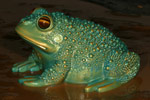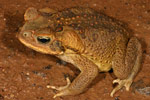Feature articles
This feature article section contains items of interest that do not necessarily fit well into the other sections of the site. The articles may remain for long periods or be updated regularly. Many of the articles will have been published previously in the pages of "In the Spotlight", the Frog Group's quad-annual newsletter.
Greywater - the why and wherefore
Lars Fields (author of a fantastic guide to building a greywater wetland in your backyard) discusses what drew him into world of phytoremediation and details some of his adventures and early experiences. It is a personal companion piece to his guide which is available elsewhere at frogs.org.au. Published April 2004.
Who is Tiddalik?
Dr John Morton is a teacher of general anthropology and Aboriginal studies at LaTrobe University. He has studied the origins and the current tellings of the story of Tiddalik and he presented this information to the Victorian Frog Group in 2006. Article updated with new information provided by John Morton in 2008.
Toad it may concern
There's no doubt that the introduction of Cane Toads has been a disaster to the Australian environment and our native animals. But just how should we feel about the toads themselves? Would we love them if they were native, or would they still be ugly? What do they "deserve"? Lydia Fucsko investigates.
Amphibian chytrid fungus - an unfortunate overview
Craig Cleeland presents his personal experience with the Chytrid fungus alongside a brief history of the disease and the research being conducted for the future. Originally published in "In the Spotlight" (Vol. 6, No. 1) during early 2001.
Victoria's newest frog
In early 1999, the Booroolong Frog (Litoria booroolongensis) was discovered in Victoria. Previously known only from NSW where it is listed as endangered, it is a significant addition to Victoria's frog fauna. Originally published in "In the Spotlight" (Vol. 5, May 1999).
Trivia quiz: in pursuit of obscure frog knowledge
The August 2001 gathering of the Victorian Frog Group was an Activities and Fundraising evening. Dave Black prepared these questions and answers for the Trivia Game Show.
News from the Amphibian Research Centre
The ARC has a close relationship with the Victorian Frog Group - what is it all about ? Originally published in "In the Spotlight" (Vol. 4, No. 3) - the report of the March 1998 meeting with guest speaker Gerry Marantelli.
The Lost Frogs' Home
An estimated 6000-8000 frogs are transported to Melbourne annually via produce as bananas and other fruits arriving from northern New South Wales and Queensland. The Victorian Frog Group has in place a system for collection of these lost frogs or banana box frogs from almost anywhere in Victoria.
Frogs and chemicals - do they mix?
Questioning the use and regulation of readily available chemical gardening products containing glyphosate. Written by Reinier Mann of the School of Environmental Biology at Curtin University of Technology.
In frog heaven
A personal account of the VFG expedition to East Gippsland in December 1996. Written by Dave Black and published in "In the Spotlight" in early 1997. Includes images and sounds.
Keeping tadpoles
A guide to the raising of pond dwelling species. Especially useful for teachers wishing to raise tadpoles in a classroom situation. Written by Joanne Doherty and Gerry Marantelli of the Amphibian Research Centre.





